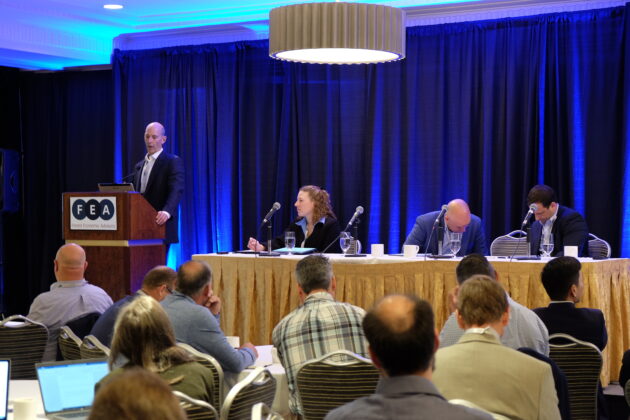
Features
Navigating the changing landscape
Key takeaways from the 2023 Global Softwood Log and Lumber Conference
July 17, 2023 By Sarah Stotler
 Photo: Annex Business Media.
Photo: Annex Business Media. The sold-out 2023 Global Softwood Log and Lumber Conference, hosted by Forest Economic Advisors (FEA), made its in-person return on June 7-8 in Vancouver, B.C. The conference provided attendees with valuable insights from over 20 industry experts. These experts delivered comprehensive market analyses and presented global industry outlooks, equipping attendees with the knowledge to navigate the uncertain and ever-evolving landscape of the softwood log and lumber sector.
Brendan Lowney, principal of macroeconomics at FEA kicked off the conference with an overview of the current macroeconomic landscape specific to the wood products industry. Lowney highlighted key industry drivers such as population growth, urbanization, and infrastructure development. According to Lowney, “The Big Kahuna, as far as wood demand, is the residential construction market. Between new construction and renovations and restorations spending, it’s over 70 per cent of wood demand in the U.S.” He explained that as the global population grows, the corresponding demand for wood products such as construction materials and home furnishings also rises. Expanding infrastructure further fuels the demand for wood products like lumber, plywood, and engineered wood. Additionally, more and more consumers are prioritizing eco-friendly and sustainable materials, making wood a favourite choice.
In the post-COVID economic landscape, Lowney emphasized the importance of recovery and resilience. Work-from-home policies, stimulus packages, tax incentives, and low-interest rates implemented during the pandemic continue to shape economic trends. He stressed the need to reconfigure supply chains as the vulnerabilities exposed during the COVID-19 pandemic highlighted risks associated with reliance on single sources.

FEA’s Paul Jannke speaks to a full house at the 2023 Global Softwood Log and Lumber Conference. Photo: Annex Business Media.
Next, Paul Jannke, principal of lumber at FEA, took the stage to discuss the lumber industry. Although the industry had anticipated a downturn, Jannke revealed that it was taken by surprise by a more significant decline in prices than initially predicted. Despite the concerns raised by the drop in lumber prices over the past year, Jannke provided reassurance that prices are expected to remain elevated in comparison to historical levels. The residential construction sector, which is a key driver of lumber consumption, is expected to experience a modest recovery in North America. However, uncertainties regarding the global economic outlook and potential trade disputes continue to pose challenges to the lumber industry’s growth.
Rocky Goodnow, vice-president of timber at FEA, covered global log market trends and outlooks in his presentation. He emphasized that the current outlook aligned with expectations, with weakened markets and decreased demand for softwood logs. According to Goodnow, the drop in log demand is primarily due to the anticipated decline in China. He explained that the strong pricing of wood products and logs over the past few years “drove the Chinese industry to utilize more of their domestic resources and we think that is going to continue to be a moderate impact in addition to the weaker outlook consumption in China.”
On the supply side, Goodnow highlighted the standing inventory of hardwood in North America. Advancements in genetics and cultivation techniques have led to higher log production capacity. Eastern Canada has the potential to increase log production, but is hindered by the lack of robust markets and significant distances between mills and log supply. The Canadian interior region also faces challenges, as their logs supply has been impacted by wildfires, disease outbreaks, and the effort to protect mountain caribou habitat.
Moving south, Goodnow was pessimistic when it came to the U.S. West Coast’s ability to increase log output. He noted Western Washington and Oregon have been affected by higher prices, losses of timberland due to wildfires, and stricter regulations on logging practices.
Next, Bill Parson delivered the keynote presentation on WoodWorks – Project Conversion, Education, and Mass Timber. Woodworks’ mission is to grow demand for wood construction in North America by removing barriers and providing resources and education to architects, engineers, contractors, and developers.
Parson utilized a case study in Northern California to demonstrate the multi-year process of engagement and education. The story began with an architect reaching out to WoodWorks for a lunch and learn session. Over the course of five years, the architect’s interest grew, leading to the design and construction of several wood buildings, including a 17-storey tallwood building and a six-storey overbuilding project. Parson emphasized that project conversion requires time, engagement, and collaboration among architects, developers, contractors, and engineers, but is well worth the effort.

Photo: Annex Business Media.
The first day of the conference wrapped up with a panel session on North American lumber trends. Representatives from Boscus Canada, Interfor, Centurion Lumber Manufacturing, and Christensen Lumber discussed key developments, challenges, and opportunities in the lumber market. Echoing earlier presentations, panelists noted that the North American market is off to a slow start in 2023, but is showing signs of improvement.
The panelists agreed that the industry is expected to experience significant growth in the next decade. A key factor driving this growth is the need for new housing, especially starter homes, combined with the repair and remodeling market, which is gaining momentum as homeowners invest in upgrades and renovations.
However, challenges remain in meeting the demand for lumber materials, especially with the potential rise of cross-laminated timber (CLT). While CLT has gained popularity in Europe, its acceptance has been slower in North America. The panelists agreed that if the industry wants to push the use of CLT it must embrace standard sizing for ease of use and cost-effectiveness.
The second day of the conference started with a panel discussion focusing on potential supply issues surrounding timber supply. The panelists underscored the importance of evaluating supply trends, adapting to industry changes, and addressing regional and global challenges to ensure a sustainable and resilient future for the forest industry.
Diego Benedetti, economic and policy advisor for the European Organisation of the Sawmill Industry, discussed the raw material supply situation in Europe. He highlighted concerns related to the aftermath of the bark beetle crisis, evolving timber policies, and the changing composition of forests in the European Union. He showcased data reflecting an overall upward trend in log supply over the past 22 years in Europe while cautioning about the potential impact of legislative measures on the industry’s competitiveness and log supply.
David Halm, senior forest economist at Campbell Global, emphasized the importance of considering macroeconomic factors, log prices, housing market conditions, and both foreign and domestic timber supply outlooks in developing log and lumber price forecasts for timberland investments.
Ross Lennox, vice-president of Woodlands Canada at Canfor, focused on log supply issues specific to B.C. He acknowledged the influence of natural disturbances such as the mountain pine beetle infestation and wildfires on timber supply in the B.C. Interior. Lennox stressed the importance of adaptive responses and considering these factors in the overall timber supply perspective.
The discussion also covered the challenges faced by the forest industry in eastern Canada, particularly in Ontario and Quebec. Issues highlighted included undercapitalization of mills, under-harvesting compared to declared cuts, labour shortages, an aging workforce, limited markets for certain wood products, and transportation costs. The panelists emphasized the need for capital investment, innovation, collaboration between industry and government, and addressing environmental and societal concerns to ensure industry sustainability in the region.
The panelists agreed that as the forest sector navigates potential supply issues, collaboration, innovation, and proactive measures will be crucial in maintaining a balance between sustainability goals and the dynamic nature of the industry. By addressing these challenges collectively, stakeholders can pave the way for a thriving forest sector that meets the needs of both present and future generations.
The two-day conference provided attendees with valuable insights into the current and future outlook of the industry. Macroeconomic drivers, market trends, and supply challenges provide both opportunities and risks. As the demand for wood products continues to grow, stakeholders must remain vigilant, adapt to changing circumstances, and embrace innovative approaches to ensure a sustainable future for the softwood log and lumber industry. “The team at FEA was very pleased to be back in person and with the turnout,” said Lowney, adding that they “look forward to bigger and better next year.”
Print this page